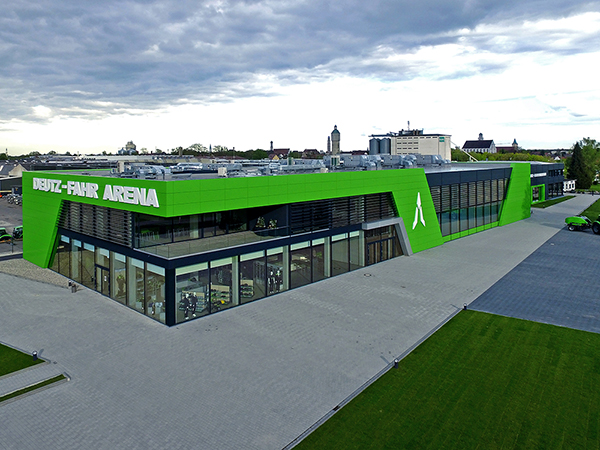The Deutz-Fahr Land tractor factory in Germany has come on line, producing the company’s 130hp-plus 6 Series, 7 Series and 9 Series tractors for the worldwide market.
Three years in the planning and construction, the new tractor factory sits on a plot of 150,000 square metres adjacent to Deutz-Fahr’s existing premises and has a covered area of 42,000 square metres.
The company says it uses state-of-the-art technology in the areas of assembly and painting and for hydraulics, electronics and chassis tests for quality assurance.
Together with the new customer centre, the Deutz-Fahr Arena, the overall investment of 90 million euros is the largest individual investment in the company’s history.
Planning for the new factory began in 2013, with a team consisting of factory employees and advisers spending several sessions pacing off areas, collating data, making calculations and discussing numerous alternative solutions.
Before the factory started operation the team went through a series of ‘live’ process simulations.
In the training workshop set up specifically for this purpose – the Design Laboratory – each workstation was developed with input from experienced employees, tested on the product to be built, documented and then implemented at the new factory.
“This provided optimum solutions and an immediate training plan while achieving a high level of acceptance among employees for their new working environment,” Deutz-Fahr says.
 |
|
The Deutz-Fahr Arena customer centre
|
Planning philosophies
In line with the target of building the most modern production facilities for tractors, the following planning philosophies were implemented (in the company’s own words):
Line back
The production line is the starting point of the planning process – all delivery processes are planned ‘backwards’ to the point of origin. This means that all upstream organisational units adapt their processes to the production plan.
In-line quality principle
Product quality has to be ensured during the entire production process. Accordingly, quality checks are integrated along the entire line to ensure maximum quality for the individual manufacturing steps.
Form follows function
The form of the infrastructure follows the functions defined by the specified processes.
Smart production
The organisational areas of production and logistics work together to allow not only ‘just-in-time’ but also ‘just-in-sequence’ production.
Workplace standardisation
Standards for processes and equipment (tools, equipment, and so on) are the basis for ensuring efficient and high quality work procedures.
“Short paths direct material flow, coupled with simplified communication and a high level of flexibility through large workshops,” Deutz-Fahr says.
“Gates at the sides of the workshops allow direct delivery of large components to the assembly line with fewer handling steps, ensuring synchronised, smooth production with low material stock.”
Synchronised logistics
On the logistics side, a warehouse with 4,000 storage locations for large parts, and a small parts facility with 25,000 locations were integrated for supplying the production process.
“Logistics use proven elements of lean production, such as continuous movement of materials on trolleys, use of route trains, e-kanban goods call-off directly from the line and continuous visual management,” the company says.
“Where material flows can be bundled economically, targeted automation was introduced: The backbone is an automatic small parts storage system for handling the standard small load carriers. It is designed as a shuttle warehouse which dynamically adapts to the throughputs varying throughout the day and the ongoing production process.
“Pre-assembly and order picking zones for add-on parts – the so-called supermarkets – are located immediately next to the assembly lines in a herringbone pattern, ensuring customised production and avoiding long paths and searches as well as extended waiting times and the corresponding safety stock levels.”
Within the production process, the assembly line design had to be extremely robust and account for the complicated installation situation, and also permit ‘just-in-sequence’ manufacturing – that is, components are only delivered at the moment when they have to be installed on the line.
Deutz-Fahr designed the assembly line as an apron conveyor with worker travel conveyors on both sides. Both move in parallel at the same speed, which allows for easier installation of tractor body parts while substantially reducing the daily walking distance.
In addition to individual quality checks at each installation step, in-line hydraulic testing and a pneumatic test take place at the end of powertrain production. The tractors then move to the paint shop and then to final assembly.
After final assembly, the computer-controlled final acceptance of the completed tractor takes place. All functions of all installed components are tested individually for each tractor, while engine and transmission are run through different speeds and load conditions.
The front axle and the front axle suspension are tested in the final phase, which Deutz-Fahr says is unique in tractor manufacturing.
Deutz-Fahr Land has a combined heat and power plant to generate the heat required for drying in the paint shop as well as the electricity for the entire production process.
Costing 20 million euros, the powertrain painting area is the largest individual investment within the factory, the company says.


